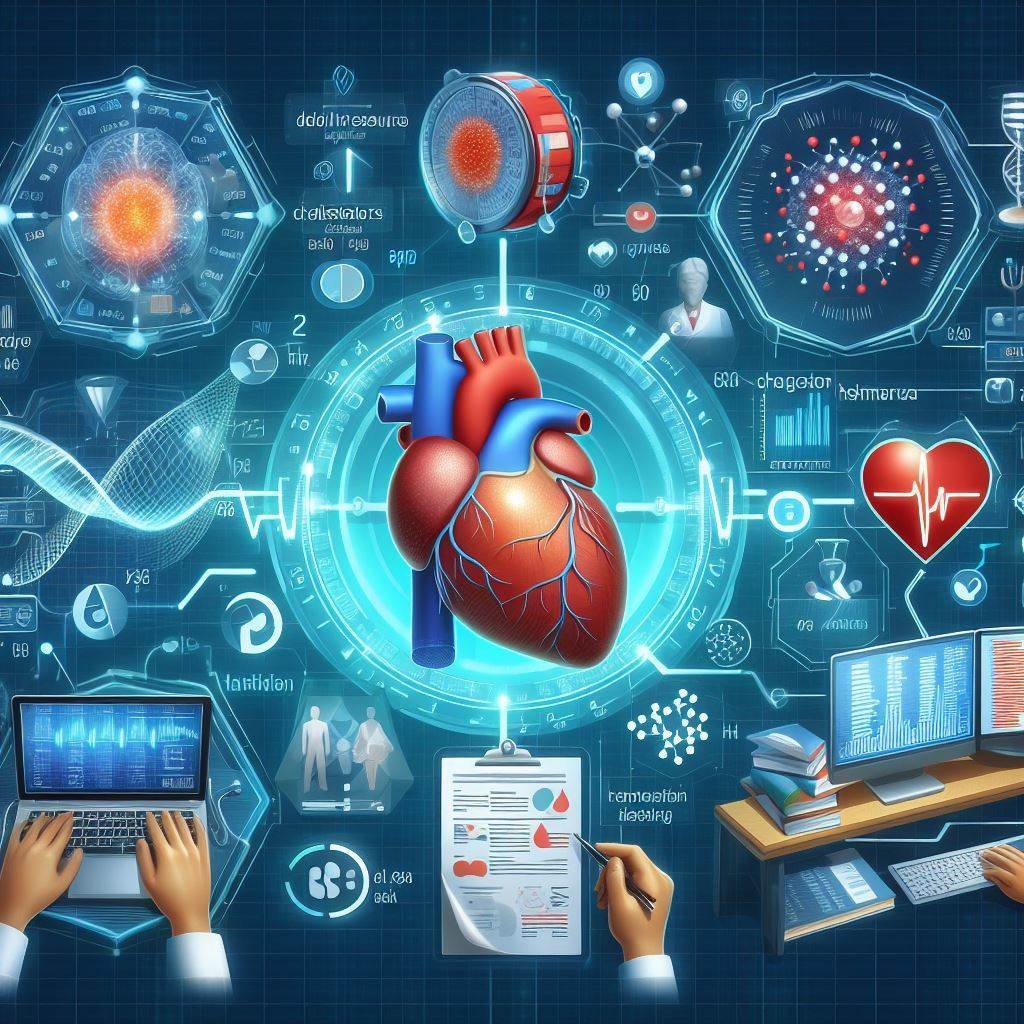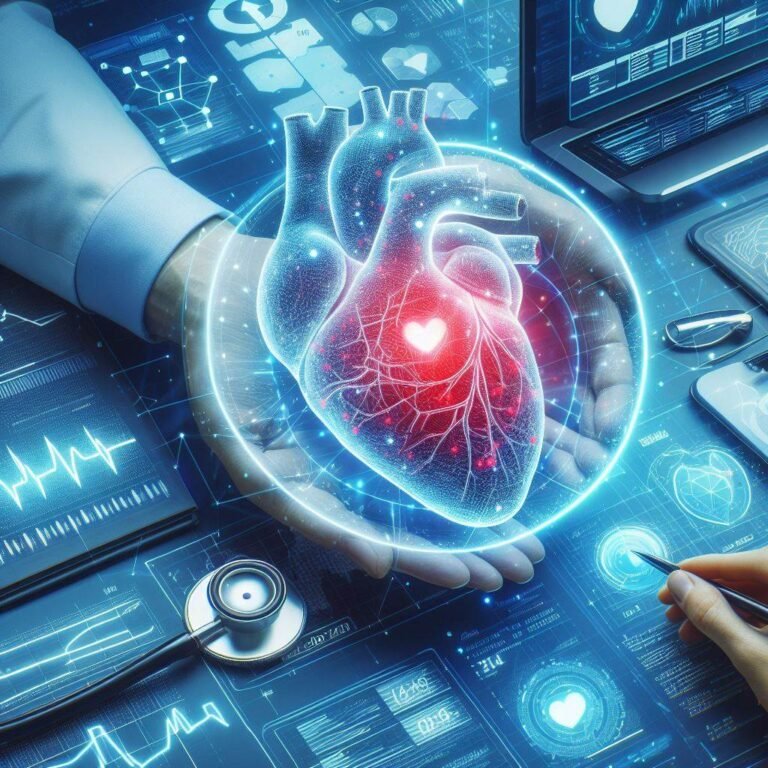Cardiovascular Disease Prediction Using Machine Learning
The field of healthcare is experiencing a transformation by the integration of cutting-edge technology. One of the most promising frontiers is machine learning, a branch of artificial intelligence that equips computer systems with the ability to learn and improve from experience without being explicitly programmed. In the context of cardiovascular health, the application of machine learning takes the form of predictive modeling, which enables healthcare providers to identify individuals at high risk for cardiovascular diseases (CVD). With a considerable rise in the incidence of CVD globally, there is an urgent need for more effective early detection and prevention strategies. Machine learning presents a paradigm shift in the way we approach cardiac care, offering data-driven insights that were previously inaccessible. This in-depth exploration of machine learning’s role in cardiovascular disease prediction is not just for the tech-savvy; it’s for anyone who is invested in the prospect of a healthier heart.
Introduction to Cardiovascular Disease Prediction Using Machine Learning
Machine learning algorithms are now being used to predict the likelihood of CVD by analyzing various health and clinical data points. It aims to zero in on the complex interplay of factors, such as genetics, lifestyle, and environmental influences, which can contribute to CVD risk. The development of these predictive models holds immense potential for personalized medicine and preemptive healthcare planning, paving the way for a more efficient and effective approach to managing cardiac health.
The Role of Data in Machine Learning for Heart Health
Data is the lifeblood of machine learning models, especially when it comes to predicting CVD. The process begins with the gathering and curation of large datasets containing diverse health-related information over time. These datasets can include blood pressure readings, cholesterol levels, genetic markers, and more. The quantity and quality of this data are critical, as they directly influence the accuracy of the predictions.
Diverse Data Sources
Hospitals, clinics, wearable devices, and even smartphone apps can serve as sources for the data needed to predict CVD. The integration of data from such diverse sources allows for a more comprehensive analysis of a patient’s health status.
Big Data and Cardiovascular Health
The concept of ‘big data’ in healthcare refers to the colossal volume and breadth of information available. Big data analytics, powered by machine learning, can identify subtle patterns within this sea of data that may be indicative of future cardiovascular issues.
Ensuring Data Quality and Security
With the sensitivity and privacy concerns of health data, ensuring its quality and security is paramount. Anonymization, encryption, and robust data governance frameworks are indispensable tools for maintaining privacy and securing patient health information.
Key Machine Learning Algorithms for Predicting Cardiovascular Diseases
There are several machine learning algorithms at the forefront of CVD prediction, each with its advantages and applications. From traditional statistical models to newer deep learning approaches, these algorithms have the potential to transform the way we forecast and prevent heart diseases.
Logistic Regression
Logistic regression is a statistical method for analyzing a dataset in which there are one or more independent variables that determine an outcome. When it comes to CVD, logistic regression can be used to predict the likelihood of a person developing heart disease based on known risk factors.
Random Forest
Random Forest is an ensemble learning method that operates by constructing a multitude of decision trees at training time and outputting the mode of the classes or the mean prediction. It is highly effective at handling large datasets and is widely used in CVD risk prediction.
Support Vector Machines (SVM)
SVM is a supervised learning algorithm that can classify cases by finding a separator. In CVD prediction, SVMs can be adept at capturing the complexity of relationships between risk factors and predicting the likeliness of future cardiovascular events.
Neural Networks
Neural networks, particularly deep learning networks, are revolutionizing the scope of CVD prediction. These networks, inspired by the structure of the human brain, can analyze extremely complex data, like genomics and imaging data, to offer unprecedented insights into CVD risk.
Understanding the Risk Factors: A Machine Learning Approach
Machine learning goes beyond commonplace risk factors like high cholesterol or family history. It scrutinizes a multitude of bio-markers and personal attributes to build a much more nuanced understanding of what places an individual at risk for CVD.
Syndemics and CVD Prediction
Syndemics refer to the aggregation of two or more diseases or conditions in a population in which there is some level of positive biological interaction. Machine learning models can identify these complex interactions and factors that exacerbate CVD risk, thus enabling more targeted interventions and prevention strategies.
Non-Linear Risk Factor Relationships
Traditional modelings often assume linear relationships between risk factors and outcomes. However, in CVD, the risk factor interactions are often non-linear. Machine learning models can detect and account for these more intricate relationships, leading to more accurate predictions.
Training Models for Cardiovascular Disease Prediction
Training a machine learning model for CVD prediction is an iterative and resource-intensive process. This training typically involves a dataset of known patient data and outcomes, which the model uses to learn the patterns and relationships needed to make predictions.
Feature Engineering
Feature engineering is the process of selecting the most relevant data points (or features) to include in the model. It often involves a combination of domain expertise and algorithmic selection to ensure the model’s success.
Hyperparameter Tuning
To optimize the performance of the model, hyperparameter tuning is conducted. These are the settings for the learning algorithm that influence the learning process itself. Finding the right balance can significantly enhance the model’s predictive power.
Model Validation Techniques
Model performance is validated using techniques like k-fold cross-validation, where the dataset is divided into k equal-sized partitions, and each partition is used as the test set. This validation ensures the model doesn’t just perform well on the data it was trained on but also on new, unseen data.
Evaluating the Accuracy of Machine Learning Predictions
The success of machine learning models for predicting CVD is measured by their accuracy, sensitivity, specificity, and positive and negative predictive values.
Accuracy and Precision
Accuracy determines how close the model’s predictions are to the actual outcomes. Precision measures the reliability of the model’s positive outcomes against all outcomes classified as positive.
Sensitivity and Specificity
Sensitivity is the model’s ability to detect true positive cases, while specificity pertains to the ability to detect true negative cases.
Positive and Negative Predictive Values
The positive predictive value measures the probability of having the disease given the positive test result, while the negative predictive value is the probability of not having the disease given the negative test result.
Machine Learning and ECG Data: Predicting Heart Conditions
A pivotal application of machine learning in cardiology is in the analysis of electrocardiogram (ECG) data. ECGs, which record the electrical activity of the heart, can provide critical indicators of potential heart issues.
Arrhythmia Detection
Machine learning models can be trained to identify various arrhythmias, or irregular heartbeats, in ECG data with high accuracy.
Ischemia and Infarction Prediction
Changes in the ECG pattern can be indicative of myocardial infarction (heart attack) or ischemia (lack of blood supply to the heart). Machine learning models are excellent at recognizing these patterns and can predict such events with remarkable speed and accuracy.
The Impact of Lifestyle Data on Machine Learning Predictions
Lifestyle plays a crucial role in cardiovascular health, and integrating lifestyle data into machine learning models can significantly enhance their predictive capabilities.
Diet and Physical Activity
Tracking diet and exercise patterns can provide valuable data for assessing CVD risk. Machine learning can quantify the effects of diet and exercise on cardiac health, leading to more personalized recommendations.
Sleep and Stress Management
Insufficient sleep and chronic stress are increasingly recognized as risk factors for CVD. Machine learning can analyze data on these factors to provide holistic assessments of cardiac risk.
Integrating Machine Learning into Clinical Practice for Cardiovascular Care
The potential for machine learning in CVD prediction is not just theoretical; it’s being integrated into clinical practice to enhance patient care.
Decision Support Systems
Machine learning models are being used as decision support tools for healthcare providers. These systems can analyze patient data in real time to assist in diagnosis and treatment planning.
Personalized Medicine and Patient Stratification
By recognizing patterns and associations that are too intricate for human clinicians to discern, machine learning supports personalized medicine. Patients can be stratified into risk-based categories, and interventions can be tailored accordingly.
Remote Monitoring
With the advent of wearable technology and mobile health applications, remote monitoring of patients’ cardiac health data has become possible. Machine learning can analyze this data to provide continuous updates on an individual’s CVD risk.
Case Studies: Success Stories in Cardiovascular Disease Prediction
Several case studies illustrate the successful application of machine learning in CVD prediction.
Mayo Clinic’s Cardiometabolic Health Congress
The Mayo Clinic used machine learning to predict patients at high risk of developing CVD and presented these findings at the Cardiometabolic Health Congress. The model included data such as systolic blood pressure, C-reactive protein, and total cholesterol.
Singapore’s National Heart Centre
The National Heart Centre in Singapore used machine learning to predict cardiovascular events with a 70-90% accuracy rate for advanced atherosclerotic vascular diseases.
Challenges in Machine Learning for Cardiovascular Health
While the prospects of machine learning for CVD prediction are exciting, there are several challenges that the field continues to face.
Data Quality and Bias
The quality of data used to train these models is pivotal, and biases within the datasets must be minimized. Biases in patient selection, data collection, and more can lead to inaccurate or unfair predictions.
Interpretable AI
The “black box” nature of some machine learning models can be a significant hurdle, as it is challenging to understand how the model arrives at its predictions. Interpretable AI is a growing field that aims to make machine learning more transparent and accountable.
Collaboration and Standardization
For machine learning models to be widely applicable, there is a need for collaboration among different healthcare systems and standardization of data collection and analysis methods.
Future of Cardiovascular Disease Management with Machine Learning
Looking ahead, the future of cardiovascular disease management with machine learning is one of increasing integration and innovation.
Proactive, Preventive Care
Machine learning will enable a shift towards more proactive and preventative care. By harnessing predictive models, healthcare systems can implement interventions before CVD develops, potentially saving countless lives.
Continuous Improvement
The iterative nature of machine learning means that these models can continuously improve over time, incorporating new data and refining their predictions. This continuous improvement cycle promises to make these models even more powerful and precise.
Mobilizing Patient Empowerment
Machine learning can also empower patients to take charge of their heart health. Through personalized risk assessments and targeted recommendations, individuals can make informed decisions to lower their risk of CVD.
Ethical Considerations in Machine Learning for Disease Prediction
The use of machine learning in CVD prediction raises several ethical considerations, including privacy, consent, algorithmic bias, and more.
Privacy and Data Sharing
Ensuring patient privacy while sharing necessary data for model training presents a significant ethical challenge. Innovations in privacy-preserving technologies are essential for reconciling this tension.
Consent and Ownership of Health Data
The issue of consent and who ‘owns’ health data must be addressed to maintain patients’ autonomy and trust in healthcare systems. Clear communication and transparent consent policies are critical.
Algorithmic Bias and Fairness
Machine learning models are not immune to bias, and addressing algorithmic bias is an ongoing challenge. Evaluating and mitigating bias will be crucial in ensuring the ethical use of these models.
Collaborative Efforts: Combining Expertise for Better Predictions
The most successful applications of machine learning in CVD prediction often stem from collaborative efforts. Clinicians, data scientists, ethicists, and more can join forces to create robust, fair, and effective models.
Cross-disciplinary Partnerships
Healthcare organizations can collaborate with technology companies, research institutions, and regulatory bodies to ensure that machine learning models meet the highest standards of safety and efficacy.
Knowledge Sharing
Sharing insights and outcomes from machine learning projects can accelerate progress in the field and foster a culture of continuous learning and improvement.
Patient Outcomes Improved by Machine Learning Predictions
The ultimate focus of machine learning in CVD prediction is on improving patient outcomes. By identifying risks earlier and more accurately, these models can lead to better health for patients.
Reduced Morbidity and Mortality
With more precise predictions, clinicians can initiate treatments and lifestyle interventions earlier, potentially reducing the burden of CVD in terms of both morbidity and mortality.
Quality of Life Enhancements
Beyond extending lifespan, improving the quality of life for CVD patients is equally important. Machine learning’s ability to tailor interventions to the individual can lead to better health outcomes and a higher quality of life.
Cost Savings
By preventing the onset of CVD or managing it more effectively, machine learning can contribute to significant cost savings in healthcare systems.
Advancements in Technology: Enhancing Machine Learning Capabilities
Advancements in technology play a critical role in enhancing the capabilities of machine learning models for CVD prediction.
High-performance Computing
The use of high-performance computing (HPC) infrastructure allows for the processing of large datasets and complex machine learning algorithms at speeds not previously possible.
Cloud Computing and Big Data
Cloud computing provides a scalable and cost-effective solution for the storage and analysis of big data. This, paired with machine learning, can unlock new insights into CVD.
Wearable Technology and IoMT
The Internet of Medical Things (IoMT) and wearable technology have made it easier to collect real-time, continuous health data, feeding into machine learning models and improving their accuracy and timeliness.
Conclusion: The Promising Horizon of Machine Learning in Cardiology
Machine learning for CVD prediction represents a paradigm shift in how we understand and manage heart health. By harnessing the power of data and technology, we are entering an era of personalized, preemptive care that holds the promise of healthier hearts and longer lives for millions around the globe. With a brighter horizon and advancements taking place at a rapid pace, the convergence of machine learning and cardiovascular health stands to deliver one of the most impactful applications of technology in healthcare. With careful consideration of the challenges and ethical implications, the future of this collaboration bodes well for all invested parties—the patients, the providers, and the pioneers steering the charge into uncharted territories of predictive health management.
FAQs on Machine Learning in CVD
Q: What types of data are used in machine learning models for CVD prediction?
Ans: The data used in machine learning models for CVD prediction can include a wide array of health and lifestyle data, such as blood pressure readings, cholesterol levels, genetic markers, diet and physical activity patterns, ECG recordings, and more.
Q: How are machine learning predictions integrated into clinical practice for cardiovascular care?
Ans: Machine learning predictions are integrated into clinical practice through decision support systems, personalized risk stratification, and remote monitoring solutions that provide real-time updates on patients’ cardiac health.
Q: What are the main challenges in using machine learning for cardiovascular health?
Ans: The main challenges in using machine learning for cardiovascular health include data quality and bias, the interpretability of AI, and the need for collaboration and standardization across different healthcare systems.
Q: How can patients benefit from machine learning predictions for CVD?
Ans: Patients can benefit from machine learning predictions for CVD through improved early detection, personalized preventive interventions, and enhanced engagement in their own health management.
Q: What is the future potential of machine learning in CVD prediction?
Ans: The future potential of machine learning in CVD prediction is vast, with the technology showing promise in enabling proactive and personalized care, continuous improvement, and patient empowerment.

















